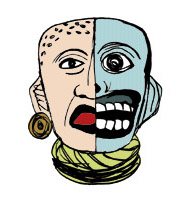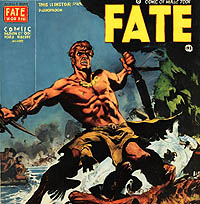I have always been a believer in the value of combat sports—even football—as reality combat models that can teach us something about self-defense. The gear, rules and restrictions do obscure some truths and encourage fighters to ‘game’ certain rules to their advantage. However, these same factors permit the fighters to apply one-hundred-percent to the struggle. An MMA fighter might not be permitted to spear the eyes, but he is permitted to hit his unprotected opponent as hard and as often as he can. All-out activity of that nature permits the self-defense practitioner to view a prize-fight with an eye toward the effects of momentum, over-extension, shock, injury, fatigue, broken rhythm and other aspects of combat that are often not safe to engage in for the self-defense student.
The essence of prize-fighting is this very fact, that these fighters are engaging in an activity that is inherently unsafe and injurious. They are making a sacrifice for the rest of us, and while prize-fights will always be imperfect as self-defense models, we can still learn a great deal from them.
To view a prize-fight meaningfully as a reality combat model ignore the start. The facing off and courtesy aspects of prize-fighting are ritualistic behaviors that never occur in true self-defense situations.
Let’s skip to the end. Self defense situations, boxing matches and MMA contests all result in knockouts about one third of the time. [MMA also has submissions of course.]This is a clue to where you want to look in a fight for your combat model. Since most self-defense situations begin with a surprise attack look to that portion of the fight when a fighter is surprised. At some point in most prize-fights it devolves into a very real self-defense situation.
Self-defense enthusiasts will carp ‘this is not the case, because the attacker and defender are limited in their options’. While it is true that the options for a prize-fighter are limited, so are the options for you and your attacker if you wish to stay out of prison. Just ask
Mister Zimmerman. The fact is most criminals choose not to use a gun or knife because they want to limit their legal risk. If you look at my article Predation in the Harm City section of my website, you will see clear evidence that most decisions made by criminal aggressors are based on their desire to limit their legal and physical risks.
Likewise, if you rip the eyes or throat out of a teenage attacker, who has two accomplices who you did not manage to bust up as they danced around behind you while you engaged the primary, these accomplices will morph into innocent bystanders who saw you—the evil karate master—maim their friend for no good reason. The States Attorney will then be encouraged by the parents of the ‘innocent child’ to add that 15 year rider to your prison term for intentional maiming. So, you too, are limited in your combat options, unless you really don’t mind doing the time.
In general, viewing a prize-fight for self-defense purposes requires you understanding the rules of the sport and being able to deconstruct the action. I will briefly touch on MMA. While it is the best model we have, there are some unrealistic things. A fighter keeping two feet and one hand on the ground, just hanging his head in the strike-zone knowing that it is against the rules for his opponent to kick him, is one glaring example of gaming the rules.
Let me now give you an example of deconstructing prize-fighting behavior. Many karate teachers [five to be exact] have personally told me that MMA is unrealistic because a wrestler can stick his head on a hip and does not have to worry about taking an elbow or hammer-fist to the spine or back of the head. Now in the hundreds of MMA bouts I have witnessed I have only seen a handful of occasions when the defender against such a wrestling takedown had the time or opportunity to strike the spine, or do anything other than hold on as they were tossed or dropped. On the other hand, every Saturday night I see wrestlers on the ground who have the back of their head so exposed that the opponent [barred by the rules from striking the back of the head] is able to repeatedly reach all the way around and cuff the man in the far ear. If he can cuff your far ear he could have hammered the back of your head.
My conclusion is that the spinal strike against the take-down is a one-in-a-hundred long shot, but that hammering the back of the head is a common option. Any such deconstruction of a prize-fight tends to lead the self-defense practitioner to a sensible training option.
Boxing
When I was a kid I could not afford karate classes, and I just was not that good at wrestling. So I decided to pursue boxing as a means of defense. The old men that taught you to box were not asking your economically strapped parents for money, just your young body.
If you see a boxing match today, involving top middle-range fighters such as Floyd Mayweather and Bernard Hopkins you will mostly see clinching by men who lack the skill to even break a clinch. Yes, the most dominant boxers of the last ten years cannot avoid or break a simple clinch. In the 1970s you rarely saw clinching among top boxers. This is the hallmark of a dying sport that is more about not losing than winning and has its roots in the preparation for, and officiating of, amateur bouts according to Olympic guidelines. Floyd throws two shots and clinches. The older Hopkins throws one shot and clinches. The lesson is very simple: the easiest defense against a punching attack—especially a counter-punch—is to simply grab the puncher. Boxers spend more time using the clinch defense than any other.
You might say, ‘But these guys are the best, surely no mortal boxer could do this to them’. In the 1990s I once conducted a study of about 200 pro bouts. Now, most pro bouts are just one-sided beatings in which a fighter without any perceived chance of victory is sacrificed to pad the record of a more marketable fighter. In every one of these fights it was to the overmatched opponent’s advantage [actually, rather in the interest of his survival] to clinch. Only 1 out of each 40 name boxers were able to avoid the clinch of their less-skilled hand-picked opponents. In many cases they never, ever, avoided the clinch.
If you go back to the foundation of MMA and the first UFC’s you will notice that no intelligent boxers, no one near the top of their class, could be recruited by the promoters. That is because all smart boxers knew then and know now that they cannot avoid the clinch of the guys they beat up on a regular in the gym, let alone some creepy snake-like martial arts master or mutant wrestler. In fact, their coaches don’t even permit boxers to practice breaking the clinch. They want the referee to do it.
When I was a teenager I did well in bare-knuckle fights against high school wrestlers. But it was thanks to my junior high school wrestling ability more than to a reliance on power punching. In fact, I knew going in that I could not crank hard punches against a wrestler. I just had to move and jab, although, at the time, I was a boxer that never threw a jab in the gym or the ring—a Joe Frazier fan who hooked almost exclusively.
Now, when you speak to urban boxers about their use of boxing in reality combat situations you rarely hear them describe their activity as anything like what they do in the gym or ring. Boxers in self-defense situations don’t want people to know they are boxers and don’t want to let the situation develop into a group attack or an armed escalation, so they tend to sucker punch. Review Floyd’s sucker punch or Ortiz and you will see how most boxers behave in ‘street altercations’. In contrast, many self-defense instructors that utilize boxing methods teach their students to apply boxing skills more like a boxer does in a ring or cage; precisely the opposite of what an actual boxer does when he finds himself in a self-defense situation.
Stick-Fighting
Regulated stick-fights are essentially duels that are delayed or ended when disarms occur. In viewing these bouts I encourage the watcher to pay particular attention to disarms, particularly disarms that do not rely on the stick.
In free-style sparring we don’t drill self-defense sets, rather we maintain a commitment to continue to a submission when disarms occur. When one fighter has a stick or two and the other has none, then you have a real spontaneous self-defense situation.
When watching a stick-fight look for that point when one fighter begins imposing his will on the other, and see if the disadvantaged fighter can pull off a reversal. Stick-fighting is very good for studying combat momentum. For self-defense purposes the ‘MMA’ stick-fight is ideal and as often as not goes to the ground.
An Example of Sport Combat as Self-defense Training
For street self-defense my favorite sport weapon set is stick & dagger. While this is a very unrealistic situation, it does, in about one-in-ten bouts, devolve into an asymmetrical weapon fight, which is much more realistic then a duel. When one of us loses a stick or dagger and is then faced with a fully armed opponent it becomes a clutch situation that features the kind of desperate actions one can expect in a spontaneous armed combat situation. About once a session we will go unarmed against the stick, unarmed against the knife, or knife against stick. It is best not to plan these. Make it spontaneous. During a stick or knife fight just toss your weapon away and go at it. This forces your armed opponent to act spontaneously.
One thing that we have found consistently is that when a fighter knows that they are losing a weapon before the opponent is aware of this, they are often able to successfully commit to a spontaneous burst of activity with a reasonable chance of success. This works self-defense for both parties at the same time. I encourage symmetrical [stick versus stick and stick & dagger] bouts for that spontaneous moment. Engaging in deliberate asymmetrical combat is a very bruising activity compared to a symmetrical dueling situation where range is more easily maintained, often ‘sympathetically’ by tacit agreement. We get our relatively safe repetitive muscle-memory development in symmetrical bouts and work on our self-defense sporadically and spontaneously, rather than through prearranged scenarios.
Conclusion
When viewing sports combat as a self-defense model:
1. Be familiar with the rules so that you know when they are being ‘gamed’
2. Take note of all fouls as potentially effective self-defense tactics
3. Be on the lookout for that change of momentum; that point in the fight when one combatant becomes the hunter and the other the hunted.
Hopefully developing the knack for deconstructing a prize-fight as a self-defense model
will make viewing your favorite sport even more fun, perhaps even helping you derive some value from those one-sided stinkers aired on cable and sponsored by Mexican breweries.
James LaFond, 5/15/12











Many lessons to be learned here.In my mind the most striking aspect that is absent from a prizefight(apart from weapons and accomplices) is only emotion.DENIAL,EXTREME ON THE SPOT FEAR,ADRENALINE DUMP(what geoff thompson describes as the"WOW FACTOR"),MENTAL LOG JAM,FEAR OF REPERCUSSIONS,INDECISION,HESITATION and many more,are not in the mind of the combat player when he faces his opponent in civillised agreed beforhand combat.Of course ,as you've said most of theSelf-defense enthusiasts will carp ‘this is not the case, and they will only argue from a technical standpoint about limitations,banned tactics, etcetera,ignoring the vast ammount of usefull lessons about combat dynamics and hand to hand combat in general,to be learned by deconstructing cage and ring fighting.
Insightful comments Alex.
I would say the biggest emotional factor of those you listed is 'fear of repercussions'. That is completely absent in prize-fighting. In many ways prize-fighting is emotionally more demanding than bad stuff that just goes down, but being haunted by the fact that you could spend the rest of you life in prison if this idiot that just swung on you gets KO'd and cracks his head on the curb, is not something combat athletes have to worry about at all.
By the way, if all of us guys who write these reality violence books were thrown together into some MMA tournament, I'd put my money on Geoff Thompson.
Thanks for checking in Alex.
THank you,Mr La Fond.For sure Mr Thompson is a formidable fighter and a pioneer reality based writer.His work on adrenaline in relation to combat,is unsurpassed,he made me realize why i was feeling like this in times of threat or danger.
By the way,very intresting thought about the MMA tournament.very nice hypothetical scenario for somebody,to practice the 'sizing up' method used by ''THE LINk" (the fighting edge page 121)
MacYoung and LaFond would not advance past the first round unless they drew each other.
Don't know about Mr Mac Young,but it is very hard to count Mr La fond out,especially when he is still fighting.
As far as MMA, I've got no business in that arena. At my age effective boxing beyond a single round is beyond me. However, when it comes to stick fighting I do seem to have a gift there that has defied age, and am still wining fights. I fought some of the best stick-fighters in the world about 10 years ago. That did not go well for me. However, I was enough of a threat that they both felt compelled to KO me where they toyed with others. Past 50 I lack the confidence to consider myself as a worthy opponent for a top stick fighter in his prime. But I still feel like a good gatekeeper/trial horse for the second tier.
I once had a bunch of Paladin books and an issue of black belt that depicted in total a dozen of us reality combat authors. These were spread out on the floor and my youngest son was wondering who could beat who. That's when the idea came to me. I remember arranging us in tournament brackets and looking at Geoff and some big mustachioed kung fu guy [name slips me] and thinking about Marc and I—yeah, us twerps are just going to be the warm up fights for these big monsters!